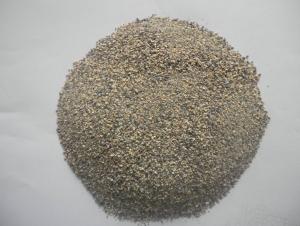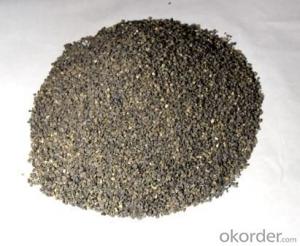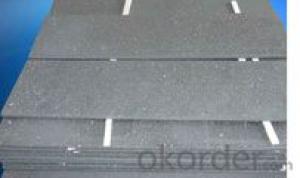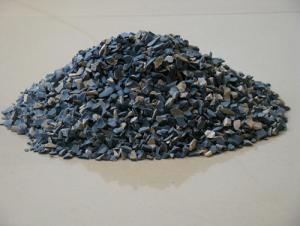Raw Materials for Refractory Silicon Carbide Support (Pillar) & Parts for Kiln Furniture
- Loading Port:
- China main port
- Payment Terms:
- TT OR LC
- Min Order Qty:
- 25 m.t.
- Supply Capability:
- 2000 m.t./month
OKorder Service Pledge
OKorder Financial Service
You Might Also Like

Reaction Bonded Silicon Carbide for Kiln Furniture and Support Component
- The high temperature strength, oxidation resistance and thermal shock resistance of Reaction Bonded SiC enables the manufacturer of low mass kiln supports. Kiln products include thin walled beams, posts, setters, burner nozzles and rolls. The components lower the thermal mass of kiln cars, result in energy savings and provide the possibility for faster product throughput.
Silicon Carbide SiC Features:
Superior Resistance to wear
Resistance to corrosion; the material tolerates a wide range of acids and alkalis
Resistance to oxidation
Abrasion / Corrosion resistance
Excellent thermal shock characteristics
Strength at high temperature up to 1380°C
Good dimensional control of complex shapesSilicon Carbide SiC Benefits:
Excellent oxidation resistance
Improved performance
Longer life between replacement / rebuilds
High thermal conductivity
Silicon Carbide SiC Specifications:
ITEM: | UNIT: | DATA: |
Temperature | Celsius | 1450 c |
Density | g/cm³ | 3.1 – 3.2 |
Open porosity | % | ≤1.56 – 1.66 |
Bending strength | MPa | 250 ( 20 c ) |
MPa | 280 ( 1200 c ) | |
Modulus of elasticity | GPa | 330 ( 20 c ) |
GPa | 300 ( 1200 c ) | |
Thermal conductivity | W/m.k | 45 ( 1200 c ) |
Coefficient of thermal expansion | K-1 x 10-6 | 4.5 |
Rigidity | 13 | |
Acid proof alkaline | Excellent |

- Q: What requirements should refractory materials meet?
- Ladle is an necessary equipment to undertake molten steel and continuous casting. As many kinds of steel needs to be processed in the ladle, including argon blowing tempering, alloy composition fine-tuning, refining dusting and vacuum processing, working conditions of the ladle lining have worsened. Their working conditions are as follows. (1) The temperature of molten steel is higher than mold casting ladle. (2) the molten steel stays longerin the ladle. (3) ladle lining are subjected to volatilization and agitation of molten steel under high temperatures and in vacuum. (4) The impact on the lining when undertaking steel liner when the impact effect. Therefore requirements of the ladle refractories are as follows: (1) It can resist high temperature. Molten steel should be able to withstand high temperatures without melting. (2) It can resist thermal shock and can withstand molten steel without cracking and spalling. (3) It can resist slag erosion. The ladle should be able to withstand the erosion of lining caused by slag and alkalinity changes of slag. (4) it should have sufficiently high temperature mechanical strength to withstand the agitation and scouring of molten steel. (5) lined should have certain swelling property so that lining will be united as a whole under the effect of hyperthermal molten steel.
- Q: Who knows about the criteria of fireproof and thermal insulation materials?
- 1. thermal insulation materials with A-level combustion performance: EPS sea capacity module, rock wool, glass wool, foam glass, foamed ceramics, foam cement, hole-closed perlite, etc. 2. thermal insulation materials with B1-level combustion performance: specially-treated extruded polystyrene boards(XPS)/ specially-treated Polyurethane(PU), phenolic aldehyde, gelatine powder polyphenyl granule,etc. 3. thermal insulation materials with B2-level combustion performance: molding polystyrene board(EPS), extruded polystyrene board(XPS), polyurethane(PU), polyethylene(PE), etc. Such A-level insulation materials are only fireproof, the thermal insulation properties are worse than that of organic XPS \\EPS materials. Currently I think that the best insulation material should be EPS sea capacity module, it not only achieves the requirement of insulation but also fulfills the goal of fireproofing, and the comprehensive unit price of it is not expensive. The thermal insulation materials in the domestic market have their own disadvantages, you'd better take the building demands into consideration, and use the materials that are within the acceptable range. I hope my answers help you.
- Q: What's the classification of flameproof glass, the refractory time of fireproofing glass.
- Classify according to the structure, fireproof?performance and fire endurance of fireproofing glass. Classify according to the structure: Composite fireproofing glass (FFB) and monolithic fireproofing glass, classify according to fire resistance: thermal insulation fire-resistant glass(class A) and non-thermal insulation fire-resistant glass (class C);classify it into 5 levels according to fire endurance: 0.5 h, 1.00 h,1.50h, 2.00h, 3.00h.
- Q: What are the components of refractory clay?
- The major raw material are bauxite, magnesite, silica, etc. It is easy to combine, high temperature resistant, corrosion resistant and has other advantages. It can be applied for refractory bricks in a variety of masonry.
- Q: What are the commonly used fire protection materials
- Firewall. The fire wall is made of non combustible material, and is directly installed on the base of the building or the reinforced concrete frame or fire proof walls . Fireproof limit of the firewall, according to the current "building regulations", is 4 hours, wheras the specification of Technical specification for concrete structures of tall building is 3 hours. doors resistant to fire, heat in a certain period of time These door usually prevent the spread of fire and gas in the fire resistant wall, staircase, pipe well. Fire door can be divided into steel fire doors, wood fire doors and composite materials fire door according to the material used. According to the limit of fire resistance can be divided into the class A fire door (1.2h), B fire doors (0.9), class C fire door (0.6h); (3) fire window. Windows resistant to fire, heat in a certain period of time It is usually installed in the fire resistance wall or doors; the fire shutter. This roller shutter can be refractory in a certain period of time. It is typically used for heat and fire insulation in escalator with difficulties to install fire resistant wall, fire resistant valve and smoke resistant valve. Fire resistant valve is installed in the ventilation and air conditioning system of air supply and return air duct, usually in the open state, fire, It will be turn off when the pipeline gas temperature reached 70 degrees, can meet the requirement for fire resistance and insulation for gas and fire. Smoke fire resistant damper installed in the exhaust system pipe, when the pipeline gas temperature reached 280 degrees, it will close automatically, insulating fire and gas.
- Q: What are the construction fire-proof materials?
- 1. fire?retardant?coating 2. fireproof?panel 3. fire proof and sealing material 4. flame resisting decorative materials 5. Green fire prevention materials
- Q: For refractory, why is it necessary to store the first mixing materials for some time under proper moisture and temperature?
- It is mainly to remove gas form chemical reactions in the pug, give full play to plasticity and binding properties of combined, and store unburned?brick whose cememting agent is phosphoric?acid or aluminium?phosphate for some time under proper moisture and temperature. For example, to avoid the formed bricks in the initial stage of drying and firing form cracking due to hydration of calcium oxide. Mixing materials is to store the first mixing materials for some time under proper moisture and temperature in order to improve the evenness and moldability of pud, such as making the distribution of combined clay and water more even. The length of storing chiefly depends on the process requirements and the characteristics of blanks. For the producing pug of high temperature kiln furnitures, the storing time is longer. The function of storing mxing materials varies with different natures of blanks. For honeycomb ceramics, it is to fully digest calcium oxide in blanks. For storing magnesia brick blanks containing much calcium oxide, it should be stored for some time in proper humidity and temperature.
- Q: I am a refractory material manufacturer, sold products, money is always not back, anxious to die, what is the way?
- Many manufacturers are facing the same problem, difficult to find the order, order the payment contract is more difficult, it is difficult to have binding, the better solution is to seek third party secured transactions, see the whole production or see full delivery
- Q: Refractory inquiries
- Neutral refractory is refractory material which is difficult to react with acid or alkaline slag at high temperature, such as carbon refractory and chrome refractory. Some of the high alumina refractories are also attributed to this category.
Send your message to us
Raw Materials for Refractory Silicon Carbide Support (Pillar) & Parts for Kiln Furniture
- Loading Port:
- China main port
- Payment Terms:
- TT OR LC
- Min Order Qty:
- 25 m.t.
- Supply Capability:
- 2000 m.t./month
OKorder Service Pledge
OKorder Financial Service
Similar products
Hot products
Hot Searches
Related keywords


























